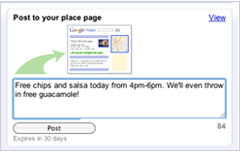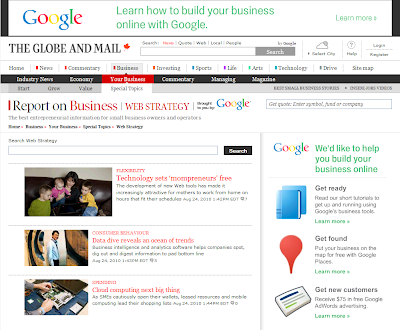Kamis, 30 September 2010
The more you know: switching to Gmail like a pro
Got By with a Little Help from my Friends
Rabu, 29 September 2010
Total disconnect
 Albert Haynesworth is being paid $100 million over seven years to play a game. And after his offseason of complaining and refusingto practice during mini-camp, he isn't playing that game very well anymore.
Albert Haynesworth is being paid $100 million over seven years to play a game. And after his offseason of complaining and refusingto practice during mini-camp, he isn't playing that game very well anymore.So he went on a Washington radio station and made one of the dumbest and most asinine comments I have ever heard. He's bitter and clinging to his guns and religion because the Redskins want him to play a different defensive scheme than he was accustomed to in previous years. I don't have a lot to say about this idiot because I'll let his own words do all the talking.
"Just because somebody pay you money don't mean they'll make you do whatever they want or whatever. I mean, does that mean everything is for sale?" Haynesworth said last week. "I mean, I'm not for sale. Yeah, I signed the contract and got paid a lot of money, but ... that don't mean I'm for sale or a slave or whatever."
No, you're not a slave. You get paid for what you supposedly do for a living. But you WERE for sale two years ago when you signed that record-breaking contract with the Redskins. They may not own your soul, but they are paying you enough money to tell you what to do while at the office
The Buzzwords this Year: Context and SIM
Selasa, 28 September 2010
A few ideas and loose ends
To do something on this scale every gram matters. I'm starting to designbthe best 3rd stage I can and works backwards... (If you do a good enough job you only need two stages)
One needs:
Efficent light high expansion motor. Working on small motors via the DMLS project.
Really light tanks.....I've purchased all the large beverage containers I can find and am weighing and pressure testing them. So far the best tank is a 2l soda bottle. 100+PSI and mass ratio of > 40. A single soda bottle is not really enough. Any scheme to group them together is heavier than the bottle. So I'm looking at maybe fabricating my own tanks. The idea H2O2 tank would be mylar lined (mylar is another version of PET like in soda bottles) with chemically compatible resins and kevlar. Normal Epoxy and normal Carbon fiber are not happy with H2O2. All the tanks at this scale are up against minimum gage issues so whatever pressure you get in the tank will be more than really needed. In concept these seem very similar to the H2O2 tanks shown by Richard Speck of Micro-space at the 2007 LLC. I've got most of the materials to try this on the way. The biggest unknown issue is how to build the liner. If I can make the process in patent #3661675work that would be ideal.
Really light valves and actuators... probably all based on brushless model airplane servos. one can get lighter brushed parts, but must trade against the requirement to put them in a pressure box and the smallest brushless ones seem to be a win.
Guidance.... more on that later...
Regulation... This one is hard because the regulatory framework that applies to orbital launches is tailored toward something like a big Atlas. My current concept is to make the 2nd and 3rd stages really light and fluffy. Almost all plastic, including the valves and plumbing. Only the thrust chamber will be non-plastic. The first stage will probably be metal. The concept is to launch off shore so that thrid party safety from the first stage is constrained by physics and the 2nd and 3rd stages are too light to survive reentry. The real trick will be proving that and path taken by the 2nd stage will either burn up or land within the 1st stage constrained by physics zone. IE if it shoots straight back down its not going so fast so it might burn up. If it flies perfectly by the end of its burn then its going to fast to survive reentry. The question is what happens between these two zones. My nominal vehicle meets all of the amateur limits except the no orbit allowed rule. IE less than 200Klb/sec and orbital altitude less than 150km. (Rules say you only need to go around once.) more rambling to follow as I figure things out.
Anyone in SoCal with access to a 14" diameter 20" long vacuum oven that I could use to try the process described in the patent above would be really helpful.
Google Places Tip and Tricks - September

Post to your Place page
Connect with your customers through Place page posts. These 160-character posts allow you to share a short update or special with users. Check out some examples and sign in now to write a quick post!
Make sure your free listing has everything it needs
You can update your business hours, add photos and make many other edits through your Google Places account. Some of the information you can update includes:
- Photos and videos
- Business hours
- Description
- Address and service areas
- Much more
- Duplicate listings
- Inaccurate information, including personal contact information or information about another business, that appears on your Place page
Success Story

Through Google Places, Dr. Jeffrey Prager's Bellinghamsmiles.com Dental Care has a continual influx of new customers, reduced marketing costs, and a high ROI.
As his practice continues to evolve, he updates his Place page to reflect any new services he offers. He might add a new video or update his business description. The listing also helps him market his business niche - laser procedures to help patients avoid painful gum surgery. Read more.
You can update your Places account at any time by signing in at http://google.com/places with your email address and password.
Posted by Bernadette Cay, Associate Product Marketing Manager
Scores on the Doors
Today's trades are my London morning in the Euro FX futures.
Senin, 27 September 2010
Event recap: How to run a successful social campaign
Last week, YouTube and SEMPO hosted a social marketing panel, "How to run a successful social campaign," for SEMPO's San Francisco and Los Angeles working groups. The panel featured speakers from YouTube, Facebook, Twitter, and Athena East, and highlighted the unique products available to marketers, and best practices for executing measurable, impactful social advertising strategies.
Derek Gordon of Yield Software was there, and shared what he learned in today's Mediapost Search Insider column.
Click here for his complete update.
Posted by AgencyAd Solutions Blog Team
Exits
Today was great. Morning was the Euro FX future (6E) which had three nice pushes up. I then switched to the ES for the RTH. No Gap trade today but there was still money that you didn't have to bend down to pick up around. Another of the EL pictures. See it in the vid. Indicator on the bottom is in test. Remember, you can see it in HD. One of our blog readers said:
If you click inside the video once it has started it opens up in Youtube. You can then click on the lower right to expand it to full screen. You can also change the resolution to 720p and get what you are looking for and more.
Rino
Radio killed the radio star
 This wasn't the first time "they" pulled the plug on Stan and Guy. But once again, Pittsburgh is left without the most trusted men in Yinzer sports.
This wasn't the first time "they" pulled the plug on Stan and Guy. But once again, Pittsburgh is left without the most trusted men in Yinzer sports.ESPN Sports Radio 1250 will cease to exist after this week because Mickey and Minnie decided that childish radio shows such as Hannah Montana will somehow be more lucrative in this cradle of sports than, well, sports. I knew something wasn't right while driving to the grocery store yesterday morning and 1250 had a national feed talking about the Cowboys instead of the Steelers. Really? The freaking Cowboys! I immediately turned the dial to NPR to find something more interesting.
But this was just a precursor to the real tragedy. ESPN Radio is pulling out of Pittsburgh and firing the entire staff. I ridiculed Ken Laird earlier this year when he erroneously predicted the end of the Bruce Arians era. However, I still think he is a good reporter with excellent insight on the Steelers. Hopefully he will be able to catch on with another radio station in the region.
This decision to end Pittsburgh's most prominent sports radio station is just another example of the demise of journalism. Whether it be newspapers that try to offer token services on their websites or radio stations that can't compete with bare bones staff, it's clear that the viewer/reader/listener no longer wants to pay for his/her services.
And that makes me sad, because this isn't the first time sports fans have faced cutbacks. Fox Sports Pittsburgh neutered us two years ago when they ended SportsBeat and the Steelers postgame coverage. For some bizarre reason, they kept the postgame show of the Triple-A team that currently plays at PNC Park.
There is no such thing as a free lunch, and this decision by Mickey Mouse proves that fact. We do not want to pay for news, but we are quickly realizing that the only free services we can find nowadays are barren news pages and dead airwaves.
Jumat, 24 September 2010
Finding your hidden treasure: international campaigns with AdWords
In 2000, Antoine Assi founded Middle Eastern export website www.aldoukan.com—it was one of the first e-commerce business in the Middle East. He was just 20 years old and he made time to develop the business in between computer science classes at his university. He needed a way to advertise his website from the comfort of his own dorm room, so he decided to test out Google AdWords.
His friends didn’t believe him when Antoine said he was going to sell and advertise traditional Middle Eastern foods and goods online. However, by 2004, his business had grown so rapidly that he decided to take leave from school to run it full-time. He then started his second company, www.mosaicmarble.com, which sells handcut decorative tiles online internationally.
Antoine believed there was a gap in the mosaic market and he wanted to share these artistic and historic decorations abroad. He knew there was a market for these tiles internationally—he just didn’t quite know where the opportunity existed. To identify these international growth opportunities, Antoine built on his knowledge of AdWords: He ran several AdWords campaigns, each targeted at the location and language of the test country.

From there, Antoine measured sales and percentage of website traffic from each country and campaign. He ended campaigns for countries with low sales volume and invested in campaigns for countries with higher sales volume and greater return on investment. Where he saw steady product sales, Antoine even had the company website translated into the language of the successful host country. As you can imagine, translating the site to the language of a country in which he’d already seen success only further promoted sales in that location.
Antoine refers to his AdWords campaigns as his hidden treasure, telling us that “the second month we started advertising on Google, we started feeling overwhelmed by the orders and the inquiries... We had to hire new employees on a weekly basis.”
Mosaic Marble quickly grew from two employees and eight artists to more than 40 employees and 120 artists. And the company’s website is now available in seven languages: Arabic, English, Finnish, German, Italian, Portuguese and French.

In addition to helping him expand his business, these international campaigns helped Antoine and his colleagues share these cultural icons with a larger part of the world. There are now homes and public spaces adorned with these ancient Greek creations in more than 50 countries worldwide. “Due to Google,” says Antoine, “we have customers such as the President of Congo, the Dubai Minister of Internal Affairs, the Princess of Jordan, and the Royal Music Academy of London.”
Posted by Elias Darwish, Account Manager, Dublin
Going Google across the 50 States: Connecticut-based ice cream franchise decides to ‘gofer’ Google Apps
Thanks for Coming
As far as the recoding of the event is concerned, we have some sound issues and Kiki is going to try to work her magic and resolve them so we can post it here on the blog. Watch this space.
Today the market opened more than 12 points up from yesterday's close. I was looking to trade the Gap. It didn't happen. You can see how I traded it in the video today. I call these failures the Anti-Gap Trade. It's like Sherlock Holmes said about the dog that didn't bark during the night - what doesn't happen can tell you almost as much as what does.
Kamis, 23 September 2010
How to Become Consistently Profitable
Rabu, 22 September 2010
More Printed Motor news...
I'd gotten some chamber quotes a year or so ago and it was still too expensive. When I had GPI quote my design again this year it was half of what last years quote was and I ordered the part on the spot. (In Stainless) GPI was also very helpful in making geometry suggestions that woul d improve the quality of the resultant part.
After placing this order I thought I'd do some more price research and sent the same file to Morris Tech to quote. The response from Morris was very competitive and its clear that this industry is seeing significant price declines. (Neither vendor knows what the other quoted) I hope its a sustainable trend and not a bloody battle to bankruptcy.
I really don't like beating vendors against each other because any long term relationship needs to be win-win and you can't do that by abusing your vendors. While it might be tempting to beat vendors prices against each other, its not some thing I do.
I also asked both Morris and GPI about the availability of Aluminum.
GPI indicated that they would soon be running Aluminum and Morris indicated that they had already run some Aluminum parts and that in the next few weeks they would be running some more aluminum test parts.
Since I was doing interesting stuff as an individual inventor not a big corporation Morris offered me the chance to add a single part to the Aluminum test run for approximately their direct cost. Its an offer I can't refuse. So I will soon have small DMLS chambers in two materials!
The Aluminum Motor is actually a bit bigger than the stainless motor as it needs to be cooled the whole length with a stainless cat pack support thermally isolated from the cooled aluminum chamber as a sleeve inside.
So if you need DMLS parts there are at least two really awesome DMLS vendors in the U.S.
http://www.morristech.com/
and
http://gpiprototype.com/
How to edit Google Maps and local business listing data
The world is a big place that’s constantly changing, so in digitally replicating it on Google Maps, you can imagine how much information we’re working with. We get data for Google Maps from a number of sources, including third party providers, business owners and users like yourself. And while for the most part, our algorithms do a great job of accurately reflecting the real world on the map, there are some instances when we get it wrong.
If you notice something that’s incorrect on Google Maps, chances are it’s either an issue with our map data - things like city and road names - or with our business listing data. We have a number of simple tools that make it easy for you to correct or report any issues so that we can get the maps right. Your assistance helps us provide the most accurate and up-to-date maps possible, so you and other Google Maps users can find what you’re looking for and be on your way.
Report a problem with our map data
Use the Report a Problem tool in the U.S. and Canada, most easily accessible by right-clicking on the map or clicking the link on the bottom right-hand-side of the map. If anything with our map data is wrong, such as a road being renamed or a new highway on-ramp opening up, please submit a report. We work hard to fix the map based on user submissions, and try to resolve these issues as fast as we can. Countries outside the U.S. and Canada should contact the Google Maps data provider to correct the information.
Edit business listing information directly on Maps
If you see incorrect information appearing on Google Maps listings in the U.S. (and many more countries), you can make updates to listings directly on Google Maps. Once we've reviewed your edits, updates to the listing will go live within several hours. If you are the business owner but have yet to claim your listing, see below for more information about Google Places.
Report incorrect business listing information
The best way to report incorrect information is to use the “Report a Problem” tool, where available. Report a Problem allows you to specify exactly what is incorrect about a listing. Once these user-submitted reports are reviewed, updates to the listing will go live in a few weeks.
If you’re a business owner, you should also claim your Google Places listing so that you can edit and update the listing that appears on Google, Google Maps and GOOG-411. Verifying your free business listing allows you to not only ensure that accurate information appears on the Place page for your business, but also enhance your online presence by adding photos, videos and even real-time updates like weekly specials to your Place page.
Claim your Google Places listing
Claim your Google Places listing by adding it at http://www.google.com/places or by clicking “Business Owner?” on the Place page for your business. Verify your listing by PIN (postcard or phone). Within an hour, click the “See your listing on Google Maps” link in your account to see your listing’s Place page. If incorrect information is appearing in your listing, there are a number of different ways to let us know and get the information corrected.
Posted by Brianna Brekke, Senior Strategist, Google Places
Competing and Adapting
Today's trades, sometimes I try and get on the bus before it arrives.
Selasa, 21 September 2010
Strengthen your advertising strategies with the Train & Gain challenge

Waiting 4 the Fed but Euros are Still Euros
Senin, 20 September 2010
Man versus Machine - survival of the fittest
REMINDER: Free 1 Hour Webinar on Thursday Sep 23 - A taste of EL
http://onlinetradercentral.com/presenter_WATG35.asp
where I'll show you how I trade and more importantly, how to learn to trade. It's not just setups but the method in the madness.
A more secure cloud for millions of Google Apps users
Sabtu, 18 September 2010
Why the motor has horns.
The horns sticking out the side are the fuel feed. The fuel goes in the curved part and a 8-32 Set screw with a orifice drilled in it goes down the straight section. Then the end of the straight section gets plugged. You can buy predrilled orfices in 8-32 set screws from Mcmaster Car.
Here is a picture of all the bits before welding:

The two small parts are the machined elbows to connect the vertical feed tubes with the Chamber top.
Jumat, 17 September 2010
Pittsburgh: Home of the Truthiness
 I couldn't stop laughing while watching last night's "The Daily Show" and "Colbert Report" on Comedy Central. Those two nuts, Jon Stewart and Stephen Colbert, announced they are hosting competing rallies in the shadow of the Washington Monument on 10-30-10. It's a big joke, but I imagine thousands will attend (including me) in a defiant gesture that there are millions of us out there who are sick of the rancor going around America like a bad case of the swine flu.
I couldn't stop laughing while watching last night's "The Daily Show" and "Colbert Report" on Comedy Central. Those two nuts, Jon Stewart and Stephen Colbert, announced they are hosting competing rallies in the shadow of the Washington Monument on 10-30-10. It's a big joke, but I imagine thousands will attend (including me) in a defiant gesture that there are millions of us out there who are sick of the rancor going around America like a bad case of the swine flu.After weeks of hearing doomsday clown Glenn Beck constantly blabbering about his Restoring Honor rally, I assumed it was only natural that the professional comedians launched their own rally.
So a few weeks ago, someone from The Series of Tubes launched a website to push Colbert into hosting a "Restoring Truthiness" rally on 10-10-10. It blew up on Facespace and the Twatter like you wouldn't believe. But what we didn't know was that it was the work of a Yinzer to get the faux conservative pundit and his Comedy Central pal/rival to organize a real event in D.C.
Joseph Laughlin, 28, of Pittsburgh, made the pioneering suggestion last month on Reddit. "I've had a vision and I can't shake it," he said when others begin chirping about a response to Beck. "Colbert needs to hold a satirical rally in DC."
It turned into an Internet sensation that has raised a quarter-million dollars for charity. It also pushed the comedians into a corner where they had no choice BUT to rally their troops. Colbert begged his viewers last week to stop sending him live doves and Beanie Babies after Laughlin's website encouraged just that.
I don't know how many people will show up for the Rally to Restore Sanity when it collides on Oct. 30 with the March to Keep Fear Alive. But I'm proud to say one of our own helped to bring the Colbert Nation and Daily Show news junkies on a collision course that very well could bring the end of days.
Well done, Mr. Laughlin. You've made the Steel City proud.
Google and The Globe and Mail Launch "Web Strategy" Resources for Canadian Small Businesses
With the proliferation of the Internet, it’s easier than ever for entrepreneurs and small business owners like you to reach new customers, promote your products, and access new markets in ways that only large corporations could manage in the past. For example, powerful and intuitive online applications such Gmail, Google Calendar and Google Docs can help you slash IT costs and enable your employees to collaborate more effectively.
To further this movement towards taking advantage of online resources, we're launching a partnership with The Globe and Mail to help Canadian small business owners and entrepreneurs expand their Web presence and use the Internet to boost sales and long-term growth. The Web Strategy section on The Globe and Mail website will bring together Google's knowledge of business in an online environment with The Globe and Mail’s insight into strategy and economic issues. The site will feature information and stories for small businesses, as well as provide tutorials about how to get started with Google’s many business tools, including Google Places and AdWords.

In the coming weeks, the Web Strategy page will explore topics such as how the Internet can transform the ways you reach new customers and how you operate your business. If you have suggestions or questions, we would love to hear them. Click here to use Google Moderator and start sharing your ideas with us.
Posted by Brett Willms, Canada Marketing Manager
If the Earth is Flat, Where's the Edge?
Trading is an endeavour when the real possibility of what you are doing may be a loss yet you still go ahead. Why? Well, after you have completed your SIM trading and have reached CP, you have gathered statistics to show that, say, out of every 40 trades, 28 are winning trades and 12 are losing trades. The only problem is that you never know in which order the winners and losers will appear. In theory, you could have 12 losers followed by 28 winners or visa versa or any mixture in between. The entry for a winning trade looks just like the entry for a loser. What makes the difference? A big trader or group of traders may take the opposite side of your trade and the order flow reverses and you have a losing trade. Unpredictable.
But if you are trading your plan with it's built in edge, then you are successful no matter the outcome because over time, you know you will make money.
The second thing I noticed was that the things people are trying to teach, in many cases is something that they can not articulate clearly and while they may or may not be making money doing it, they certainly don't seem to be successful at knowledge transfer. A critical part of teaching is to be able to transfer your knowledge to a student so he can replicate your success. Your success not necessarily your style. The methodology you learn needs to be market agnostic and time frame agnostic to have longevity. It must keep on working forever. Markets change in volatility and rhythm but all liquid markets have an order flow that you can trade successfully if you know how to read it.
That is what trading is.
Great opportunity today in the ES. i was exchanging emails with one of the guys I mentor and we were talking about the gap trade. The market was way above yesterday's close and there was my favorite: a zipper.
You can see the result in the video. BTW, fyi, Youtube massages the video for what looks like the first 15 minutes after it's posted to improve HD.
Going Google across the 50 States: Minnesota-based allnurses.com gets rid of its email servers

Kamis, 16 September 2010
Making AdWords Account Management Easier
As a small business, you may find that investing in marketing can be a catch-22; while you are looking to grow your business, your time is limited and budgets are tight. While AdWords has always been about making advertising as measurable as possible, we are well aware that time is money - especially when you are a small company. So, in an effort to help you preserve your most precious asset, we wanted to share a few of tools we’ve developed as part of our effort to make account management less time-intensive.
Use the Opportunities Tab to Find Customized Account Optimization Suggestions
Incorporating data from both user search behavior and the performance of your own account, the Opportunities tab is an excellent tool for garnering suggestions that can help you to improve targeting, expand your reach or increase the effectiveness of your marketing spend. To make improving your campaigns as easy as possible, the Opportunities tab lets you review ideas and apply them directly to your account. You can also save these ideas as “pending changes” in case you want to think about them and add them later.

The ideas shown on the tab are generated by our system just for your account, so look them over carefully before you try them. Some may not fit your own needs, but some may help to improve your campaign performance.
Automatic Bidding is the easiest of the AdWords bidding options. With automatic bidding, the AdWords system automatically adjusts your maximum cost-per-click (CPC) bids on your behalf. You still set your daily budget, but rather than specifying individual bids for ad groups, keywords, or placements, the AdWords system actively seeks out the most clicks possible within the budget you set.
Let Us Help You Gain More Conversions with Enhanced CPC
Enhanced CPC is an easy-to-use automatic bid management tool intended for advertisers already using conversion tracking who are looking to turbo-charge their return on investment. The tool automatically adjusts your Max CPC bid each time your ad is shown in order to maximize the likelihood of your ad will converting. As a result, your ad should receive more conversions while maintaining or reducing your overall cost-per-conversion.

To learn more about Enhanced CPC, you can visit our help center or watch a short video.
Monitor Account Changes with Ease Using Custom Alerts
You can create custom alerts in your AdWords account so you're automatically notified when certain behaviors and/or changes occur within your campaigns and ad groups. This enables you to constantly track increases or decreases in the metrics that matter to you or metrics that have reached a certain threshold you set. To learn more about this feature, please visit our help center.
Is everyday a ground hog day?
Morning in Europe was OK but after our lunch, not much was happening.
A few nice Euro trades.
Rabu, 15 September 2010
Broadcast your business through the TV for All Contest
















